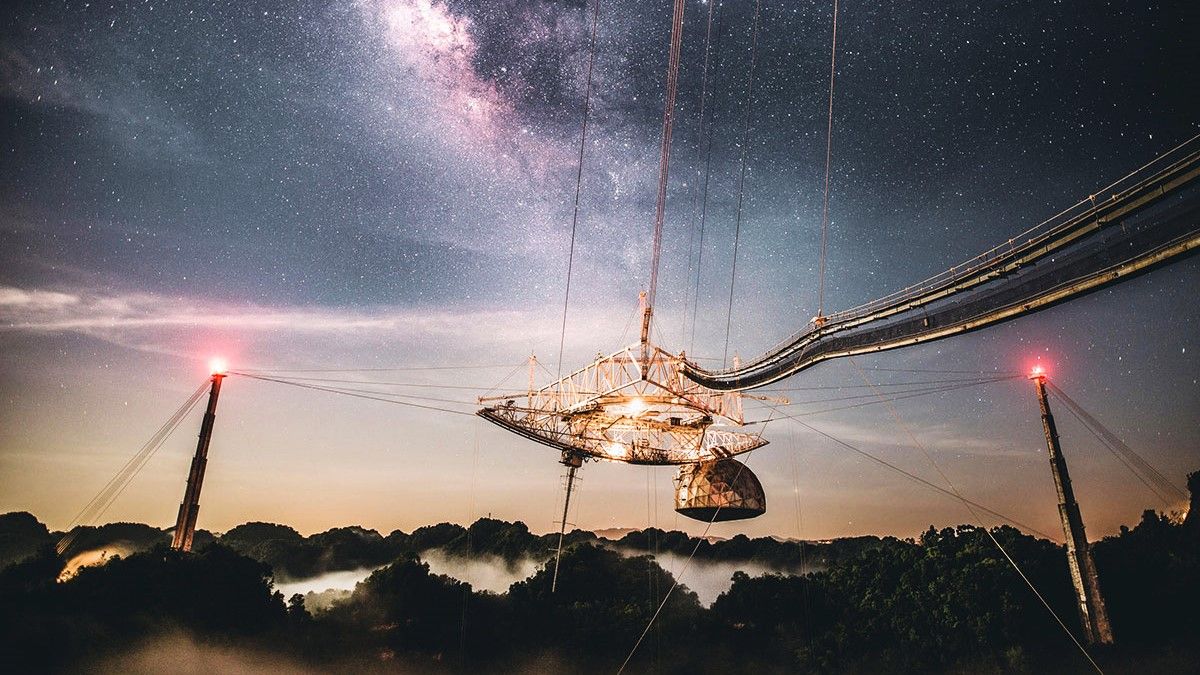
Puerto Rico’s iconic radio telescope, which collapsed in 2020, won’t be rebuilt, although the site will see a new education center open next year.
The Arecibo Observatory‘s massive radio dish was an unusual facility because it was a key player in three different fields of science: atmospheric studies, radio astronomy and planetary radar. Opened in 1963, the telescope’s observing equipment hung from a web-like platform strung over a massive dish 1,000 feet (305 meters) wide. But in December 2020, the cables supporting that platform gave out and the equipment crashed down through the delicate dish, destroying the telescope.
Now, the National Science Foundation (NSF), which owns the site, has determined that despite scientists’ pleas, Arecibo Observatory won’t be getting any new telescope to replace the loss. The new education project also doesn’t include any long-term funding for the instruments that remain operational at the observatory, including a 40-foot (12 m) radio dish and a lidar system.
“We were worried that it could be even worse than this, that they might say, ‘OK, just close down everything,'” Abel Méndez, an astronomer at the University of Puerto Rico at Arecibo who used the telescope in his research and teaching, told Space.com. “But my particular hopes were higher.”
Related: Losing Arecibo Observatory would create a hole that can’t be filled, scientists say
Read more: Puerto Rican scientists mourn loss of Arecibo Observatory’s iconic telescope
Instead, the NSF intends to build on the observatory’s legacy as a key educational institution in Puerto Rico by transforming the site into a hub for science, technology, engineering and math (STEM) education, due to open in 2023, according to a statement (opens in new tab). The observatory is also home to the Ángel Ramos Foundation Science and Visitor Center, which opened in 1997.
“The U.S. National Science Foundation issued a solicitation Oct. 13 for a new multidisciplinary, world-class educational center at the Arecibo Observatory in Puerto Rico that aims to serve as a hub for STEM education and outreach,” officials wrote in the statement. “The center would expand upon existing education and outreach opportunities currently in place at the Arecibo Observatory site, while also implementing new STEM programs and initiatives.”
The statement’s discussion of the science facilities at Arecibo is minimal, although it does note that teams who want funding to use the existing instruments or build new ones can “can submit proposals that are complementary to the scope of the new center.”
NSF’s program solicitation (opens in new tab) for the new science center notes that the agency expects to provide $5 million over a five-year period. According to the Associated Press (opens in new tab), the NSF also intends to provide the observatory with a five-year maintenance contract worth at least $1 million each year. Méndez called that enough to keep the lights on, but not a budget to support research.
The telescope’s troubles began in 2017, when Hurricane Maria battered Puerto Rico, although the observatory suffered little damage. In early 2020, a spate of earthquakes rocked the island, temporarily closing the observatory. But for a while, the facility still seemed like it would be fine.
In August, that changed, as one of the thick cables supporting the 900-ton platform slipped out of its socket and fell through the dish, leaving a gash in the delicate panels. Still, engineers developed a repair plan and said that the situation was under control.
Related stories:
But in November, just before those repairs were due to begin, a second cable failed. As they analyzed the situation, engineers determined that the telescope was too unstable to repair safely; NSF decided to decommission the instrument. But gravity won the day, with the telescope collapsing early on the morning of Dec. 1, 2020.
Since then, scientists have called for the telescope to be rebuilt, or for an even more capable instrument to be built at the site to replace it. Instead, the Arecibo Telescope’s legacy will live on most notably in the form of its decades of archived data.
“For decades you probably will be hearing ‘a paper from Arecibo Observatory,'” Méndez said.
Email Meghan Bartels at mbartels@space.com or follow her on Twitter @meghanbartels (opens in new tab). Follow us on Twitter @Spacedotcom (opens in new tab) and on Facebook (opens in new tab).



